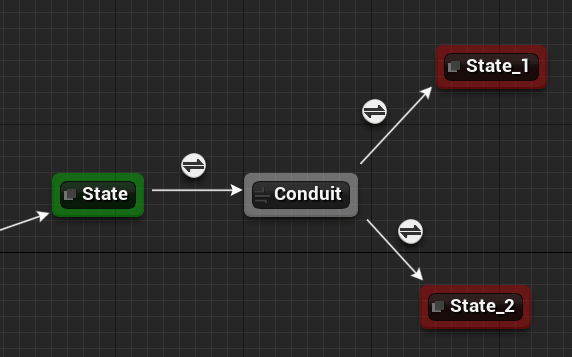Conduits¶
Conduits consist of a boolean operation which must be true before any outgoing transitions are evaluated. A state will not switch until the conduit and all connected transitions and conduits pass.
Conduits are helpful if you have a common base transition that you want to branch into multiple paths.

Video¶
Properties¶
Eval with Transitions¶
The conduit is treated as a transition, and if any conduit or transition fails in a path leading to or from the conduit, that entire transition chain fails and won't be taken. Conduits and all connected transitions will be evaluated (and possibly taken) at once in a single tick. This allows conduits to behave similar to animation graph conduits.
If unchecked the conduit is treated as a state and may be entered, but will not exit, until its condition becomes true. Custom conduit node classes allow On State Begin, On State Update, and On State End to be defined and will only fire if the conduit is configured as a state. When configured as a state On Conduit Entered will fire when the conduit is first entered, regardless if the conduit evaluates to true or not.
- This setting defaults to true.
- If you need state-like behavior, it is generally better to use a state node rather than a conduit node.
Can Evaluate¶
Allows the conduit condition to be evaluated.
Conduits and Events¶
The best way to use event-based transitions with conduits is to have the first transition listen to an event. Then have the conduit and all subsequent transitions and conduits in the chain read values and evaluate conditionally, not relying on events.
Using multiple events in a transition chain will be unreliable as the order the events fire may not allow correct evaluation. All nodes need to be able to evaluate the moment the first transition evaluates, in a single tick.
The performance will be as good as if they were event based since they won't be evaluated until the first transition evaluates to true.
Entry States¶
Conduits can be setup as entry states, however they will always be forced to act as a state. If you have a sub state machine with the first node as a conduit, the moment the sub state machine becomes active, the conduit will become active, and will not transition to the next sub state until the conduit becomes true.
Parallel States¶
Conduits do not support outgoing parallel transitions.